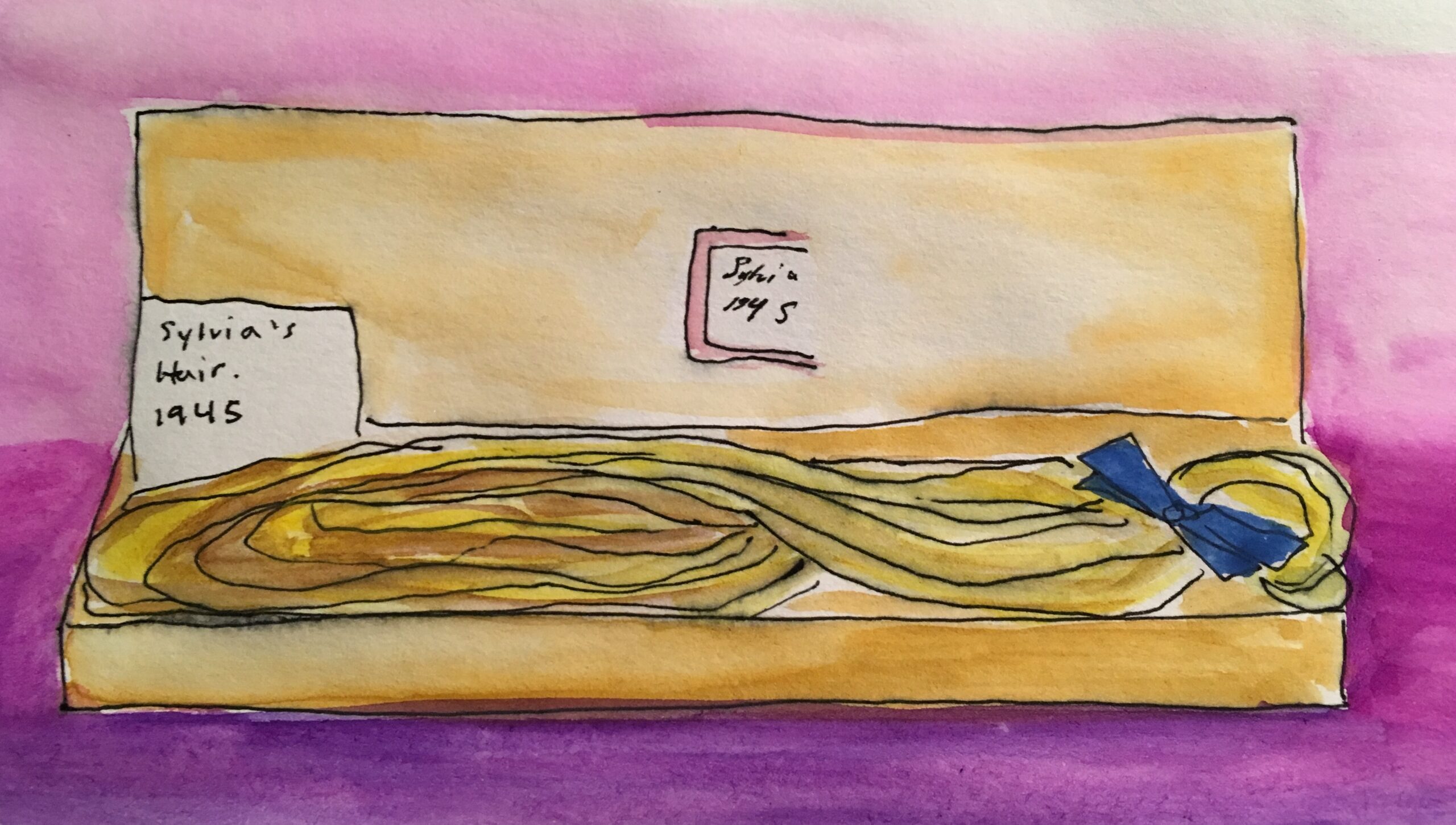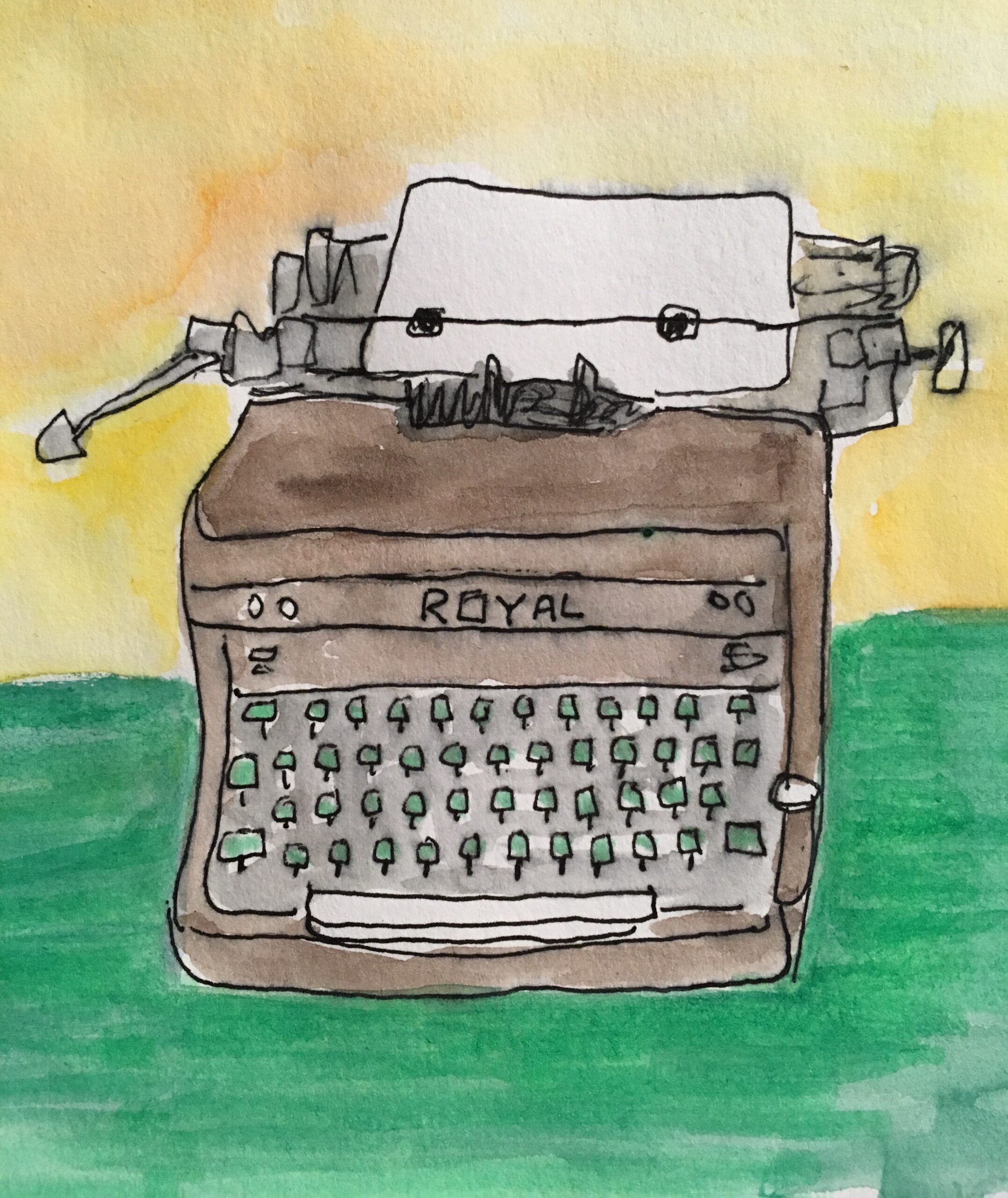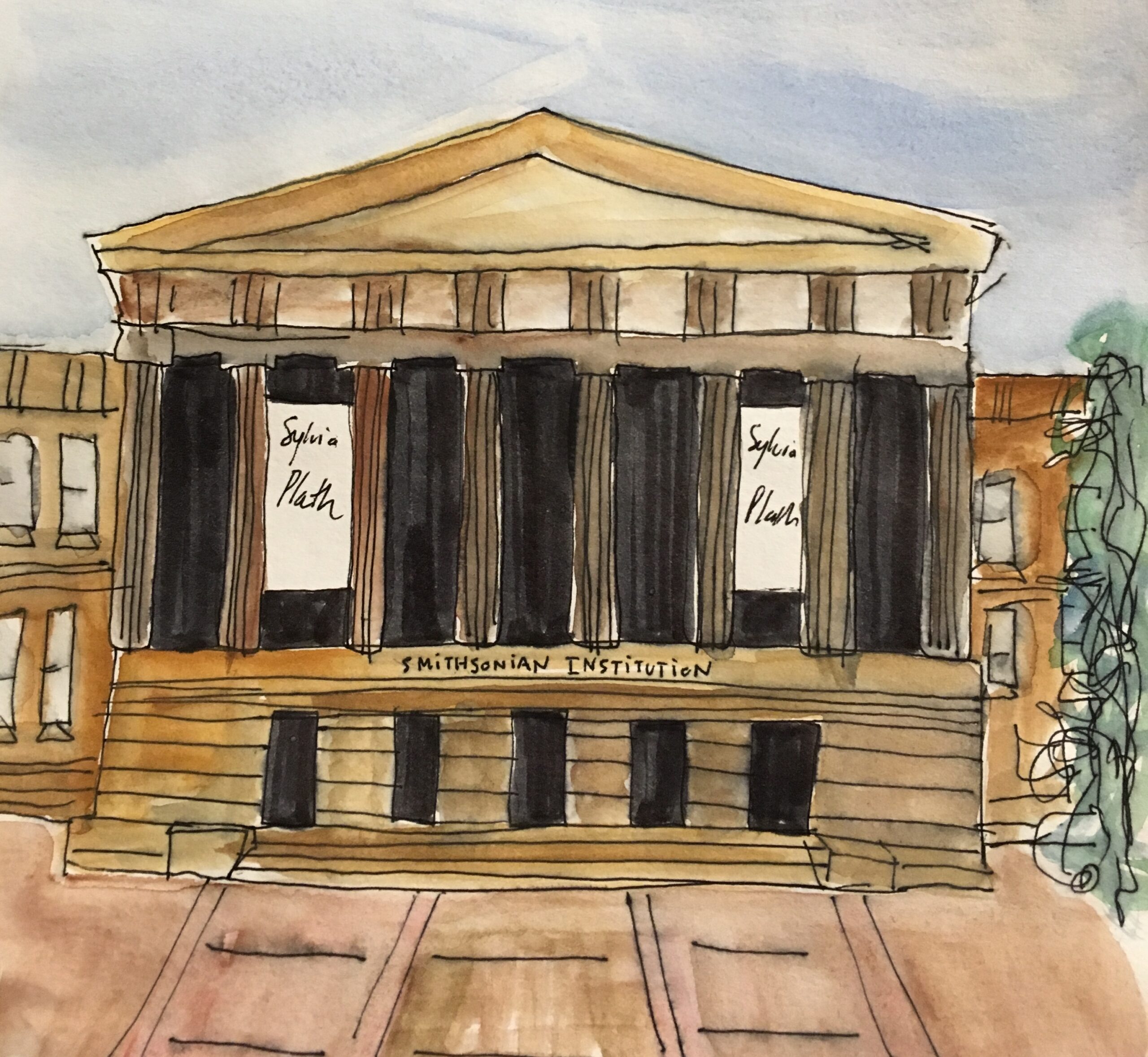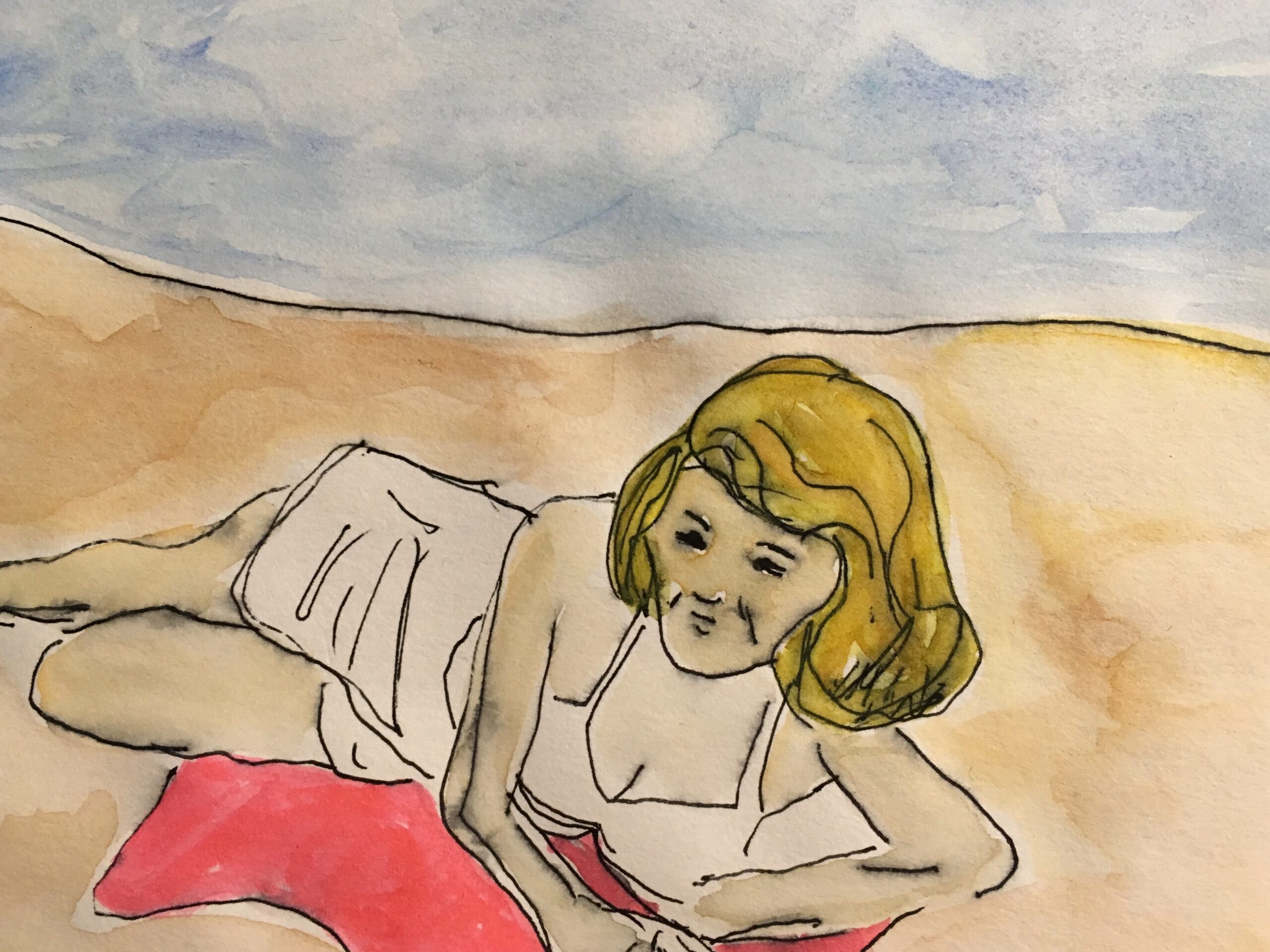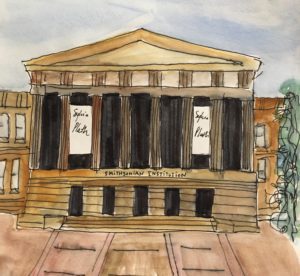
The “One Life: Sylvia Plath” exhibit at the National Portrait Gallery in Washington, DC evokes a certain kind of worship. I went because my world was starting to feel small in the way it always does when autumn arrives. Winter did not worry me, with her long darkness and sharp air. No, the transitional fall ate at me, a slow reminder that the time to do all things was fading. Like most who grew up by the sea, summer is my season. I spent my adolescent summers in bathing suits and flip flops, sucking sand and salt into my bones.
At my town’s public beaches, I learned how to center myself in crowds of strangers. Beaches operate on a delicate understanding: we all want to enjoy a shared space on our own terms. When I snuck onto private beaches—I was always poor, as most townies were—there was more space between bodies, longer stretches of sand unturned, more quiet. This is where I learned how to watch. The rich fascinated me from a young age, what with their gentle way of living above others. The beach is where I learned how to be comfortable among people, how to mimic them, move like them. I loved any excuse to interact with a body that was not my own.
Any excuse to look at a face that was not my own.
The exhibit is limited to one room, but on the Saturday afternoon I visit, it’s easily the most crowded in the museum. A woman with a baby strapped to her chest snaps a selfie with an early draft of “Lady Lazarus,” crafted on Plath’s famous pink paper. The woman doesn’t smile. Just a few feet away, several young women take turns capturing Plath’s typewriter, enclosed behind glass. One woman spends a long time looking at Plath’s childhood ponytail, tied with a ribbon and displayed behind glass. Preserved by her mother in 1945, it shows the natural, untouched color of Plath’s hair. More importantly, it suggests a surprising intimacy within a relationship known for being volatile. Looking at it makes me wonder how long death stays soft.
In the center of the room, “Glass Hearts (Bells for Sylvia Plath),” an interactive art installation composed by Jenny Olivia Johnson, invites viewers to tap on suspended glass bell jars, causing the work to emit different notes depending on how it is touched. Everything in the exhibit, I would learn, depends on your approach.
Plath lovers will recognize much of what is displayed: the infamous bikini shot, book covers, snapshots with Ted Hughes that suggest a happy marriage and veil his alleged abuse. Her face watches from all walls. People crowd her collages, subversions of magazines where she used copy designed to sell makeup and fashion to question authority, power, and war.
Outside of people-watching, I look at one book. In a small display, Plath’s copy of The Autobiography of Alice B. Toklas sits behind glass. Gertrude Stein wrote the book, not Plath (and not even Toklas herself). Story has it that Stein wrote the entire thing in just a few days motivated mostly by money. It’s a tongue-in-cheek take on memoir that poses important questions on which narratives belong to whom. Hemingway allegedly hated it, which prompts me to appreciate it all the more. But in the Plath exhibit, I am taken by her doodles in the book.
The book is open to the last page. Directly below the last line, a sketch fills the rest of the page. It’s a Parisian cafe, filled with small tables and chairs and people. On the inner back cover, a large sketch of a woman looks into the cafe. Her gaze is focused, face tilted directly at the action. On the bottom of the last page, an anonymous hand holds a pen and draws.
Plath draws an observer to the café—presumably, Plath herself—recording the scene within her scene. And not just any observer: an observer drawing the picture we see before us. Plath sketches herself in, but not as a passive actor. She is watching, recording, crafting a narrative shape. A pervasive notion is that watch is to remain neutral. That to gaze upon someone or something can be neutral. This is never true.
Plath’s sketch reminds me that to gaze is always to insert.
In Patricia Highsmith’s novel, The Price of Salt, two women fall in love. Highsmith, a lesbian herself, centers queerness. Suspense is present—before the novel was brought to the screen in 2015 as Carol, Highsmith was mostly known for Strangers on a Train and The Talented Mr. Ripley—in the form of detectives, hotel rooms, hidden guns, and a custody battle. The Price of Salt is written in limited third person with a tight, crisp focus on Therese, a nineteen-year-old shopgirl who falls in love with Carol, a rich, older woman going through a divorce. Therese is frustrated with a world that she understands will not be kind to her if she holds Carol’s hand in public. Refreshingly, she doesn’t turn that frustration into anger against herself.
The first time I read The Price of Salt, I had to do it very slowly. I read a few pages, then hid it. I had to lie down and close my eyes and repeat lines in my head, already committed to memory. I underlined. I folded. I’d been out for years, yet I had to pause the book to read it.
At the start of Carol and Therese’s story, Richard is present. He matters little, aside from his incessant belief that Therese is heterosexual. He offers much to Therese, who is at best apathetic toward him: his warm family, a sharp contrast to her life as an orphan, boat tickets for a trip to Europe, the privilege of passing as heterosexual. Like many men, he is so certain of her heterosexuality that he believes it is only a matter of time before she will want him back.
He also offers his gaze.
Before long, Richard becomes deeply suspicious of Carol. Finally, he asks, “What do you mean you’re fond of her? Do you want to go to bed with her?” And Therese replies, “Do you think I would tell you if I did?”
Of the moment immediately after this exchange, Highsmith writes:
[This] made it almost impossible to keep walking beside him. And glancing at him, she had seen him looking at her with that soft, inane smile that in memory now looked cruel, and unhealthy. And its unhealthiness might have escaped her, she thought, if it weren’t that Richard was so frankly trying to convince her she was unhealthy.
They converse a little more in the same line, and Highsmith continues:
He stared at her and for a moment beneath the anger she saw the fixed curiosity she had seen before, as if he was watching a spectacle through a keyhole. But she knew he was not so detached as that. On the contrary, she sensed he was never so bound to her as now, never so determined not to give her up. It frightened her. She could imagine the determination transformed to hatred and to violence.
To watch a person watch you is a funny thing. Just as we understand observation as a neutral point, we also understand it as an invisible one. Of course, this is not true. To watch, after all, is also to reveal. Sometimes to understand another’s gaze is to understand violence. It is, perhaps, impossible to record a gaze and show its full impact to someone who has never been its target. Sometimes watching a person watch you teaches you that they see you as an object, an obstacle, a challenge. Sometimes, closing our eyes offers protection. Often, it doesn’t.
The summer I moved to DC, I had very little time to go to museums. I worked as a cashier at a grocery store known for their organic products. The job was not all bad; I got decent hours and above-minimum-wage pay within walking distance from the small studio I called home.
Rushes came at familiar hours. Around 6 p.m. every weekday, when people who worked in offices got out of work, our store was the place to be. Customers bought groceries, of course, like grass-fed beef and non-GMO soy milk, but they also came for the wine tastings and occasional live music. In busy times, customers rarely made conversation, which I appreciated.
One afternoon, a man watched me very closely. He watched me scan his items, bag them, tap the register to process his payment. He smiled at me the whole time, trying to meet my eyes. A few registers down, a customer yelled at one of my coworkers. Involuntarily, I jumped back. The area around us became quiet, momentarily, before a fresh rush of people in business attire hurried past. I tried to pick out the angry customer, but he was already gone. In this, my customer caught my eyes.
“You looked scared just then,” he said. I nodded to confirm his view; yes, I had been frightened. He said, “I like that.” The whole time he spoke to me, he smiled.
Walking home that evening, I passed many glass doors: those of convenience stores, coffee shops, luxury apartment buildings. I avoided looking at my own face. I did not want to know what my fear looked like. I still don’t.
Perhaps as women we are always trying to record the gaze. Marginalized people are often asked to validate our distrust, trepidation, and fear. People want to know: What happened, precisely? They suggest, kindly, that you have misunderstood the person’s intent.
This need to validate how others look at us can bleed deeper. I look at myself in the mirror: Is my right eye bigger than the left? How long has the mole on my chin been one centimeter? I go to the doctor for the first time in years, and she asks me if the mole has changed. I have no idea, and for months after, I obsess over it. Is it darker today? Has the border shifted? Illness scares me, but the obsession comes from elsewhere. No one, I want to tell her, has taught me how to evaluate myself.
A year before that appointment, I sit in a chair at the salon in Georgetown, a wealthy neighborhood in DC that continues to intimidate me. The stylist asks me if I part my hair on the left or the right. His question is innocuous, valid, non-aggressive. I say right, then left. I cannot remember. I resist the urge to fact check myself and look at pictures on my phone. Few things in the world matter less than the side of my head in which I part my hair. I know this, but I cannot stop. Do I know what I look like? Or do I remember what I used to look like? Left and right function as a duality which should be simple.
Somehow, I cannot find my center.
The first time I saw a topless woman, I was thirteen, and I was at the beach. She was all bronze, except for the white triangles of her breasts. Mostly, she did ordinary things: drank water, sprayed oil onto her chest, twisted her hair into a bun on top of her head. She looked a little sad, but I didn’t wonder why.
Instead, I thought about her breasts: I imagined the weight of them, if they’d fit in my hands, if her nipples were erect, if they’d taste like the bubblegum in my mouth or saltier, like the air. I stared at her the whole afternoon, even after she laid down on her stomach, even after a big man came and sat down next to her. At first they kissed, then they talked for a while, and I imagined they were arguing. Eventually, he took his shirt off and went into the ocean. I was relieved she did not go with him.
I went back throughout the summer, hoping to see her again, though I never did.
Years later, I had sex with a woman. It was not the first time either of us had sex, but it was our first time together. Afterwards, I looked at her breasts, considered the weight of them, concentrated on my then-empty hands and tried to remember the size they’d taken up in my palms. She distracted me with a kiss. I say distracted because I kept my eyes open and saw her expression while she did it, how she pulled the sheet up over her bare breasts, concealing all of her besides her shoulders. Later, when we had sex again, the sheet was gone and I experienced her breasts again. The terms were hers. Sheet, then no sheet. Sheet, then no sheet. We shared pleasure on mutual terms.
What I am getting at is that I am slowly understanding that when I gaze, I, too, take.
At eighteen, Plath painted a self-portrait in which her face is split into colorful fragments. It feels cubist and post-impressionistic. Her left eye appears larger than the right. Her lips are crooked. Her hair has sharp edges. I am drawn to it initially because although it is bright, it is not happy. Her mouth is a neutral line. The only black in the image is in her eyes, expressionless. In the exhibit, I look at this painted self-portrait, then at her photographed portraits again and again. I am unsure which depict her most accurately.
Plath’s diary, dated from 1953, is behind glass. It is open to a page where she had inserted a small photo of herself. On the lines surrounding the image, she wrote, “Look at that ugly dead mask here and do not forget it. It is a chalk mask with dead dry poison behind it, like the death angel. It is what I was this fall, and what I never want to be again. The pouting disconsolate mouth, the flat, bored, numb, expressionless eyes; symptoms of the foul decay within.”
Plath was deeply invested in the creation of the self. More specifically, her creation of her selves. The blonde, fun and sensual, tanning on the beach. The brunette, smart and serious for academia. The curation of all of her selves made me ache swiftly and fiercely and I found myself feeling voyeuristic, even guilty, for being yet another person to consume her creations. So I leave.
I go to a cafe several blocks away and buy a coffee that burns my hands through its thin paper cup. The door is thick, heavy glass. I hold my coffee in one hand and use the other to open the door. It does not budge. I push my shoulder against it, and in doing so catch my reflection. Immediately, I wonder: Is this what I looked like yesterday? An hour ago? Fifteen minutes ago, when I entered? I feel a man approach from behind, hear him huff, feel him express his frustration at my presence in the door, an unexpected obstacle. I do not avert my gaze from myself to focus on him. After all, I do not need to see these things to understand them. I linger in the doorway another few seconds.
I look at my face, and I do not forget it.
***
Rumpus original art by Elizabeth Schmuhl.

